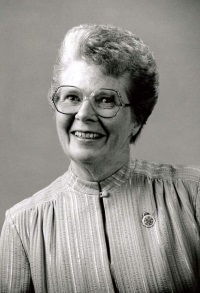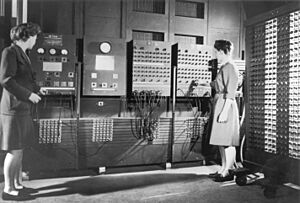Frances Spence facts for kids
Quick facts for kids
Frances Spence
|
|
|---|---|
 |
|
| Born |
Frances V. Bilas
March 2, 1922 |
| Died | July 18, 2012 (aged 90) |
| Alma mater | Chestnut Hill College |
| Occupation | Computer programmer |
| Employer | Moore School of Electrical Engineering, University of Pennsylvania |
| Spouse(s) | Homer W. Spence (1947-death) |
| Children | 3 |
| Awards | Women in Technology International Hall of Fame |
Frances V. Spence (born Frances V. Bilas; March 2, 1922 – July 18, 2012) was a very important computer programmer. She was one of the first people to program the ENIAC. The ENIAC was the world's first electronic digital computer. Because of her work, she is seen as one of the first computer programmers ever.
The other five ENIAC programmers were Betty Holberton, Ruth Teitelbaum, Kathleen Antonelli, Marlyn Meltzer, and Jean Bartik.
Early Life and Education
Frances V. Bilas was born in Philadelphia in 1922. She was the second of five sisters. Her parents both worked in education. Her father was an engineer for the Philadelphia Public School System. Her mother was a teacher.
Frances went to South Philadelphia High School for Girls. She graduated in 1938. She first attended Temple University. Later, she received a scholarship and moved to Chestnut Hill College. She studied mathematics and also physics. She graduated in 1942. While at college, she met Kathleen Antonelli. Kathleen also became an ENIAC programmer later on.
In 1947, Frances married Homer W. Spence. He was an Army electrical engineer. He had also worked on the ENIAC project. After her marriage, Frances stopped working to raise her family. She had three sons: Joseph, Richard, and William.
Working on the ENIAC Computer

The ENIAC project was a secret project by the United States Army. Their goal was to build the first all-electronic digital computer. Men mostly built the computer's parts. But a team of six women led its programming. These women were called "Computers" at the time.
Frances and the other women were very important. However, their work was not fully recognized back then. This was because people thought women were not interested in technology. Pictures of these women working often did not say who they were. When the ENIAC was finished in 1946, the US Army did not mention the women programmers. This made it seem like women were not a big part of computing.
The University of Pennsylvania's Moore School of Engineering hired Frances and the other women. They needed to calculate ballistics trajectories. These are the paths that bullets or rockets travel. The US Army funded the Moore School. They hired women because many young American men were fighting in World War II.
Frances and her college friend Kathleen Antonelli were part of a smaller team. Besides their main programming duties, they also operated a machine called a Differential Analyzer. This machine helped calculate ballistics equations. All the women on the ENIAC team were very good at doing these calculations by hand too. After the war ended, Frances continued to work with the ENIAC. She worked with other leading mathematicians.
Legacy and Recognition
In 1997, Frances Spence was honored. She was put into the Women in Technology International WITI Hall of Fame. The other original ENIAC programmers were also inducted. Their work was very important. It helped create the electronic computers we use today. Their ideas started the rise of computer programming after World War II.
In 2010, a documentary film was released. It was called "Top Secret Rosies: The Female "Computers" of WWII." This film focused on interviews with three of the six women programmers. It showed the amazing contributions they made during World War II.
Another documentary, The Computers, was made in 2013. It was inspired by the ENIAC team. This film uses old footage of the ENIAC team from the 1940s. It also has interviews with the women as they remember their time working together. This is the first of three documentaries. The next two will be called The Coders and The Future-Maker.
See also
 In Spanish: Frances Bilas Spence para niños
In Spanish: Frances Bilas Spence para niños

